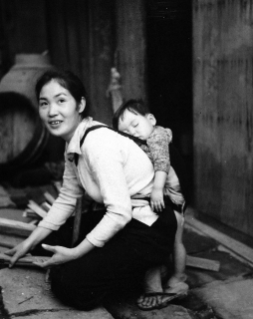Beate Sirota was a 22-year-old language expert working for the Allied occupation authorities in Tokyo in 1946 when she wrote one of the most important paragraphs in Japanese history.
One of a handful of women on the staff of General Douglas MacArthur, the Supreme Commander for the Allied Powers (SCAP), Sirota was tasked with drafting a section of the proposed Japanese constitution that would establish civil rights for Japanese women involving marriage, money, and family.
When adopted as part of Japan’s postwar constitution, the sentences Sirota wrote redefined the role of women in Japanese life, upending a thousand years of cultural and social tradition, exactly the result that MacArthur was looking for. Along with the renunciation of war and the strengthening of Japanese democracy, the equality of women was a key part of MacArthur’s plan to smash the power of the Japanese militarists who had disastrously led Japan into World War II.
Women had never enjoyed equal rights in Japan. Marriages were arranged and adultery was permitted for husbands, but not for wives. Women could not own property and had no legal, economic, or political rights. High schools were segregated by sex, and there were no colleges or universities for women at all. MacArthur was determined to halt Japan’s traditional gender discrimination, and Beate Sirota would play a key part.
Sirota was born in Austria, the daughter of a well-known concert pianist. But the rise of Nazism terrified her parents, Russian Jews who had emigrated to Vienna. When Sirota’s father was invited to teach and perform in Japan, they grabbed the opportunity. From ages five to fifteen, Sirota lived in Japan, where she learned the intricacies of the Japanese language and of Japanese society, including the powerlessness of Japanese women.
In 1939, at age 15, having completed secondary school in Japan, Sirota enrolled at Mills College in Oakland, California. She was there in December 1941 when the Japanese attacked Pearl Harbor. Unable to return to Japan, she completed her studies and obtained work as a translator. For nearly four years she had no direct contact with her parents.
As soon as the war ended, she looked for a job that could take her to Japan, so that she could search for he parents. Fluent in Japanese, she quickly found work as a language expert with the U.S. government’s Foreign Economic Administration supporting the Government Section of SCAP in Tokyo. Upon arrival in Japan, she located her malnourished parents, who had survived the war despite constant government suspicion.
In February 1946, the Government Section was assigned to draft a new constitution for Japan. The document would need to be approved by General MacArthur before submission to the Japanese government, which would have final say. MacArthur wanted to use the new constitution to make far-reaching social changes in Japan. Belying the importance of the task, the Government Section was given just eight days to prepare their initial draft.
As the lone woman in the unit, Sirota was assigned to write the section on women’s rights. It didn’t matter that she had virtually no government experience and had studied modern languages in college. She was a woman – the only woman readily available – and that was qualification enough.
Undaunted – indeed, energized by the tasking – Sirota quickly toured all of the available libraries in Tokyo, gathering samples of constitutions that could guide the Section’s work. She found the German Weimar Constitution of 1919 to be especially helpful. The Japanese Meiji Constitution of 1889 was useful mostly as a template for what not to include, she noted later.
On her own initiative, Sirota also drafted a section that would protect Japanese children from exploitation, ban full-time child labor, and ensure free medical and dental care for children.
“Believing this was a chance Japan would never have again,” she wrote, “I wanted to be sure not to omit a single thing that might benefit Japanese women in the future.”
While the section on children’s rights and many of the specific details of her section on women’s rights were dropped by U.S. officials, the document that was ultimately presented to the Japanese for review included her language guaranteeing equality for women. When Japanese officials saw the American draft, they were initially opposed to the section on women’s rights. But when an American officer pointed out that the section had been written by Sirota, who had lived in Japan for more than ten years, was fluent in the language, and understood the point of view and feelings of Japanese women, Japanese officials relented, and the article remained in place.
Later, many of the specific requirements Sirota had drafted that were dropped from the constitution were incorporated into legislation, and thus became law.
Sirota served in Japan until 1947. For the rest of her life she worked as a translator, primarily for the Asia Society, a non-profit organization dedicated to improving relations between Asian nations and the west. She died in New York City in 2012.
Article 24 of the Japanese Constitution, promulgated on November 3, 1946:
Marriage shall be based only on the mutual consent of both sexes and it shall be maintained through mutual cooperation with the equal rights of husband and wife as a basis.
With regard to choice of spouse, property rights, inheritance, choice of domicile, divorce and other matters pertaining to marriage and the family, laws shall be enacted from the standpoint of individual dignity and the essential equality of the sexes.
For further information on Beate Sirota Gordon’s experiences in Japan, see her memoir: The Only Woman in the Room, Kodansha International, Tokyo, 1997.
Photo: Occupation of Japan, 1945. Scene at Sasebo, Kyushu, Japan, shows mother working with sleeping child on her back. Photographed by crewmember of USS Chenango (CVE-28), released October 19, 1945. Official U.S. Navy photograph, now in the collection of the National Archives. (2015/12/01).
January 10, 2019
